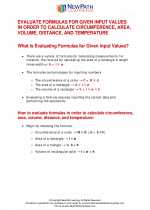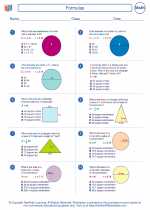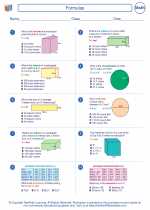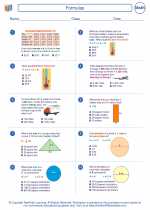Trigonometric Functions
Introduction
Trigonometry is a branch of mathematics that deals with the study of angles and the relationships between the sides and angles of triangles. Trigonometric functions are mathematical functions that relate the angles of a triangle to the lengths of its sides. The three main trigonometric functions are sine, cosine, and tangent.
Sine Function (sin)
The sine function of an angle in a right-angled triangle is defined as the ratio of the length of the side opposite the angle to the length of the hypotenuse. It is denoted by the abbreviation "sin". The sine function is periodic, with a period of 2π, and its range is between -1 and 1.
sin(θ) = Opposite / Hypotenuse
Cosine Function (cos)
The cosine function of an angle in a right-angled triangle is defined as the ratio of the length of the side adjacent to the angle to the length of the hypotenuse. It is denoted by the abbreviation "cos". Like the sine function, the cosine function is also periodic, with a period of 2π, and its range is between -1 and 1.
cos(θ) = Adjacent / Hypotenuse
Tangent Function (tan)
The tangent function of an angle in a right-angled triangle is defined as the ratio of the length of the side opposite the angle to the length of the side adjacent to the angle. It is denoted by the abbreviation "tan". The tangent function is not periodic, and its range is all real numbers.
tan(θ) = Opposite / Adjacent
Additional Trigonometric Functions
In addition to sine, cosine, and tangent, there are three reciprocal trigonometric functions: cosecant, secant, and cotangent. These functions are the reciprocals of sine, cosine, and tangent, respectively. They are denoted as csc, sec, and cot.
Applications of Trigonometric Functions
Trigonometric functions have wide applications in various fields such as physics, engineering, architecture, and more. They are used to model periodic phenomena, analyze waveforms, solve navigation problems, and much more.
Study Guide
To master trigonometric functions, it's essential to understand the definitions of sine, cosine, and tangent, as well as their relationships with the sides of a right-angled triangle. Practice solving trigonometric equations, understanding the unit circle, and applying trigonometric functions to real-world problems. Additionally, familiarize yourself with the graphs of trigonometric functions and their properties.
Remember to also study the reciprocal trigonometric functions and their properties. Practice using trigonometric identities to simplify and solve trigonometric expressions. Finally, apply trigonometric functions to solve problems related to angles of elevation and depression, periodic motion, and more.
With consistent practice and understanding of the concepts, you can become proficient in using trigonometric functions effectively.
.◂Math Worksheets and Study Guides Sixth Grade. Formulas

 Activity Lesson
Activity Lesson
 Worksheet/Answer key
Worksheet/Answer key
 Worksheet/Answer key
Worksheet/Answer key
 Worksheet/Answer key
Worksheet/Answer key
